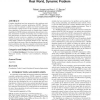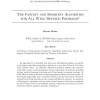1651 search results - page 87 / 331 » Measuring the Complexity of Classification Problems |
IJON
2008
13 years 6 months ago
2008
The problem of inductive supervised learning is discussed in this paper within the context of multi-objective (MOBJ) optimization. The smoothness-based apparent (effective) comple...
CG
2010
Springer
13 years 6 months ago
2010
Springer
Generating, grouping, and labeling free-sketch data is a difficult and time-consuming task for both user study participants and researchers. To simplify this process for both part...
CORR
2007
Springer
13 years 7 months ago
2007
Springer
Modular structure is ubiquitous in real-world complex networks. The detection of this type of organization into modules gives insights in the relationship between topological stru...
ATAL
2008
Springer
13 years 9 months ago
2008
Springer
Complete algorithms have been proposed to solve problems modelled as distributed constraint optimization (DCOP). However, there are only few attempts to address real world scenari...
CORR
2002
Springer
13 years 7 months ago
2002
Springer
An algorithm M is described that solves any well-defined problem p as quickly as the fastest algorithm computing a solution to p, save for a factor of 5 and loworder additive term...


